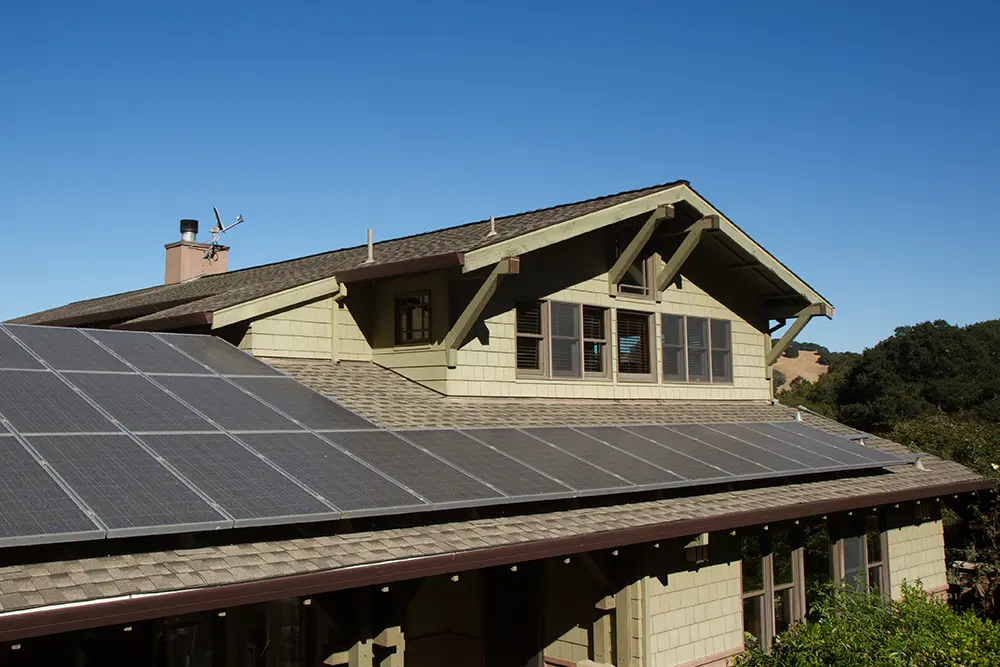Repairing or replacing the roof on your home can be one of the most expensive renovation projects you’ll ever have to deal with as a homeowner. Your roofing material is visible, it absorbs sunlight and heat from the sun to warm your home, but can also let that same heat escape during cold nights. Therefore, you should give serious consideration to the energy efficiency and durability of a material before purchasing it.
But the question of sustainability is an important one, as almost no roofing material qualifies as truly sustainable. If you think of “green” as solely referring to living roofs, it may surprise you that many types of roofing materials can also be considered sustainable. There are many different types of roofing materials, and each has its own unique set of benefits and drawbacks. As with any major building project, you should do your research before making a final decision, and that’s where we come in.
Factors for Environmental Performance
Roofing materials that are considered green or environmentally friendly must not only be manufactured in a way that is respectful of the environment, but they must also perform well and can be disposed of properly. The key factors in efficiency are durability and a material’s ability to prevent heat gain, two factors that can greatly affect the cost of maintaining an appropriate temperature inside the home. The Energy Star program certifies a number of roofing materials for their ability to reflect heat away from the building and reduce cooling costs. However, this Energy Star certification is not limited to specific roofing materials—it can also be applied to a roof’s design, installation and maintenance.
What Makes Roofing Sustainable?
The issue of whether a material is sustainable or environmentally friendly depends on its source more than other factors. A sustainable material is one that is produced in an ecologically balanced way, and that primarily means without depleting or damaging its resource permanently.
Many environmental experts say that, in addition to considering how a material is sourced, it’s also important to consider whether the way it was harvested or created has caused significant damage to the environment.
Due to this definition, any roofing material that is made from fossil fuels or mined materials (resources that cannot be replaced once they have been depleted) is not sustainable.
Assessing the Greenness of Roofing Materials
Slate Roofing
Slate is a beautiful option for roofing that can last longer than the house beneath it, but it’s expensive to mine and process and difficult to transport. Most slate comes from the Northeast, but mining stone is not a sustainable practice. Furthermore, slate roofing is heavy and requires more extensive roof framing than lighter-weight materials, which negates any of the the overall environmental-friendliness of the choice altogether.
Metal Roofing
While metal roofs require large amounts of energy and resources to make, they are attractive, durable, and often contain a high percentage of recycled material or can be easily re-used at the end if their life cycle. Though metal roofs reflect some heat and may help reduce heat gain, they must be insulated properly because the metal is highly conductive.
The most common metal roofing materials are steel and aluminum. Unfortunately, mining for metals is not sustainable because it removes earth materials from their natural state.
Clay Tile Roofs
Clay tiles, which are also called terra cotta, are durable and heavy. They’re expensive as well. Clay tiles are made with clay that is shaped and fired in a kiln, like ceramic tile. Some tiles are even given special treatments that enhance their appearance or durability. There is a great deal of clay available for making tiles, so many tile manufacturers claim their products are sustainable.
Asphalt Shingles
Standard asphalt shingles, also known as composite or fiberglass shingles, are a moderately durable roofing option that offer some heat reflectivity if they have an appropriate design and color. They are made from paper, minerals such as clay and rock, fiberglass, tar (a type of sticky black liquid), and coal. Because asphalt shingle recycling is not economically feasible on a large scale, most old shingles are discarded in landfills where they tend to not biodegrade. As they are a petroleum-based product, they are not environmentally friendly.
Wood Shingles and Shakes
Wood is arguably the most sustainable roofing material, since wood can be harvested from trees without harming their ability to regenerate. Of course, this assumption is only valid if the roofing material used was harvested sustainably. Producing shakes and shingles is a fairly energy-intensive process, and they are only moderately durable—much less so than slate or clay tile.
However, wood roofing is easy to dispose of because it is biodegradable (literally “decomposable by bacteria”), provided that its treated with only non-synthetic additives or preservatives. If you are able to source locally produced shakes and shingles made from FSC-certified wood, this can be an especially sustainable choice.
Fiber-Cement Roofing and Concrete Tile
Concrete roofing tile and fiber-cement shingles are made with Portland cement, a material that requires large amounts of energy to produce. It is estimated that the production of a ton of cement generates about 1 ton CO2.
However, these roofing materials are extremely strong and last for a long time. Concrete tiles are heavy, so the existing roof framing may need to be reinforced. Fiber-cement shingles weigh less than slate and can be made to resemble it, but they are much easier to damage.
Green Roof Systems
Green roofs are also called living roofs, as they consist of vegetation on a flat or low-slope roof that is partially or completely covered by plants—preferably native species. The materials used in a green roof include soil, water-resistant polyethylene sheets and sedges, rushes or grasses.
Although they require regular watering and maintenance, green roofs offer many benefits: They prevent water from running off your property into the storm drain system, and they even can insulate your home against outside temperatures. In urban areas, green roofs help to reduce the heat island effect by absorbing some of the sunlight that would otherwise be reflected off concrete and asphalt.
For all its benefits, a green roof is not so environmentally friendly if the material used to waterproof it—a heavy-duty rubber membrane made of petroleum—isn’t sustainable. Even if their benefits may outweigh the costs of installation, green roofs are heavy and require additional roof framing for support.
How to Choose Sustainable Roofing Materials
- Coatings – Avoid roofing materials made with copper or zinc, which can wash into water sources and are dangerous to aquatic life.
- Recycled Content – Check the content label on roofing materials to see if they are made with recycled material. For most people, the higher the percentage of recycled content in a paper product, the better, but durability always wins out in the end. Also, confirm that the material will be recycled again at the end of its life to make new products.
- Weight – On the surface, it might seem that a heavier roof is better than one made of lighter materials, since heavy roofs tend to be more durable and less likely to rip off in bad weather. In order to avoid causing structural problems for your home, you should be sure that the existing structure can support the weight of new roofing material. Be sure to consider what that means toward the sustainability of your overall product, too.
- Maintenance – It would be a shame to spend so much time and money maintaining your roof every year. Be sure your roof is made of a material that will last and does not require any toxic cleaning products.
- Reflectivity and color – If you live in a particularly hot climate, look for light-colored roofing materials that are highly reflective. Such surfaces will bounce more of the sun’s rays than darker ones—which can turn your home into an oven.
- Roof slope – The type of roof you have— whether it’s flat, low-slope or high slope — has a significant impact on what kind of material works best, so be sure to take this into account when selecting your building supplies.
- Warranty – Get the roofing product with the longest warranty, which indicates that it is of good quality and will last a long time.





